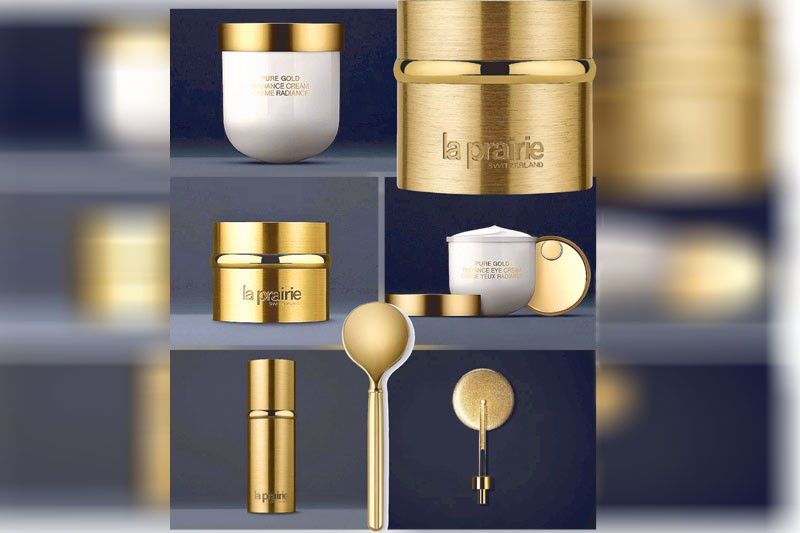‘Buying our world more time’

Refillable packaging is the future of beauty. It’s convenient; it’s sustainable. As for the dilemma of making it desirable enough for customers to never want to throw it into a landfill, La Prairie rises to the challenge with packaging designed like objets d’art: Bauhaus-style golden vessels for its new Pure Gold collection.
What’s inside is gold — literally. The two creams in the three-product gold-infused range come with an 18K gold-plated spatula to scoop it out.
“It is a totally new, forward-looking collection,” says La Prairie’s chief marketing officer Greg Prodromides during its product launch. “We used this to express our new sustainability journey of luxury with a higher meaning.”
Greg also announces La Prairie’s ongoing and long-term patronage of the Glaciology Section of ETH Zurich, Europe’s number-one scientific university, a collaboration initiated by La Prairie in 2019.
The Swiss luxury skincare brand is inspired by the fleeting moment of The Golden Hour in the crown of the Alps — it is majestic, but it is also the first to be affected by global warming.
“Glaciers are among the most prominent indicators of climate change, as they integrate the effects of climate over a certain duration,” explains Glaciology Section’s professor, Dr. Daniel Farinotti. “Glaciers are an important element of our landscape — just think of a Swiss postcard — and the white mountains you’ll see in the background! Both the refillable vessels and glacier-related research support a similar goal: buying our world more time. By reducing waste and giving funds to trigger new ideas to save Alpine glaciers, we are acting in the present to inform and preserve the future. The future we want. The future the next generations deserve.”

Greg also announces Hong Kong-born artist Carla Chan’s artist residency in the Monte Rosa Hut — a first for La Prairie. Carla’s time-based video installation will be revealed in Freize New York in early May as part of the brand’s new partnership with the fair, and Art Basel Hong Kong at the end of May. She will also create exclusive work to be exhibited in the La Prairie House in Hong Kong.
What does gold actually do in skincare?
Pure Gold is comprised of a glimmering concentrate, a snowy opalescent eye cream and cream that promises to imbue radiance. Fans of the brand already know this benefit from the popular Radiance line. The difference lies in the addition of gold and active ingredients.
“This specifically serves devitalized skin,” says Jacqueline Hill, La Prairie’s global director of strategic innovation and science. “A hallmark is the reduced receptiveness of its cells to nutrients and signaling molecules which slows down many cellular processes. It’s dull, severely dry, thin, rough, and fragile.”
The promise is restoring volume, hydrating deeply, eliminating barrier deficiencies, and thickening the skin — but how?
“Gold’s surface chemistry allows us to attach specific active ingredients to gold particles and have them released in a time-controlled manner,” Jacqueline explains. “Using pure gold particles of an average size of 60 microns, a large number of gold atoms are located at the particle surface. These surface atoms do not fully interact with each other as the inner atoms do. In consequence, surface atoms are free-binding sites in the form of electrons, which are available for attaching active ingredients. Such actives will be gradually released from the gold over time when they interact with specific biomolecules present on the skin surface.”
The active ingredients are a replenishing peptide and a polyphenol attached to the gold particles’ surface, as well as the peptide and the polyphenol each in free form; this allows the actives to penetrate the skin in separate “waves.” It is also enriched with La Prairie’s proprietary Exclusive Cellular Complex. Pure Gold is also the richest in texture out of all La Prairie collections.
From the point of view of sustainability, ethics, and safety, Greg assures that “Both in terms of formulation and packaging development, we consider the different aspects of the journey.”
The formula is contained in a glass vial that you can lift from the brass metal casing once you’re done and bring to the store for recycling. After your first purchase, you will only need to replenish with refills.

The future of Glaciers
La Prairie and The Glaciology Section at ETH have three things in common: science as a heritage and passion — they are both Swiss institutions — and they are both intrinsically linked to the notion of time, be it La Prairie’s pursuit of timeless beauty or the long-term cycles of glaciation and de-glaciation that the section collects data of. We learn more about their work and what they’ve done with La Prairie so far from ETH Glaciology Section’s professor-doctor Daniel Farinotti.
The Philippine STAR: By looking at the glaciers, what can we learn about climate change?
Daniel Farinotti: Glaciers respond slowly to climate and cumulate the effect over time. This means that they help us visualize changes that would otherwise be difficult to perceive. Global temperatures have risen by about 1°C since the industrial revolution, and one is tempted to think that 1°C is very little — I’m not able to tell if an egg was fried at 184°C or 185°C. For a glacier, however, 1°C of difference has a huge impact. To give an example: compare two pictures of the Aletsch Glacier in 1850 and now — you’ll be shocked!
Let’s talk about ETH’s partnership with La Prairie. What do you like the most about interacting with La Prairie?
The partnership with La Prairie enables us to reach an audience that we would never have been able to reach before. As scientists dealing with glaciers and pristine environments on a regular basis, we feel the responsibility of alerting the broader public that rapid changes are ongoing, and that action has to be taken if we want to preserve this beauty through time. La Prairie feels very much the same way, and this is what brought us together.

What have you been able to achieve to date with the support of La Prairie?
So far, the support of La Prairie has been directed towards two activities to help us achieve our overall purpose of establishing a better understanding of glaciers behavior and how to best preserve them.
First, we were involved in measures set in place to mitigate the damages caused by the sudden drainage of a glacier lake. For the past decade, this drainage happened annually, and caused damage in the municipalities downstream. Here, we accompanied the project scientifically, notably learning more about the processes that govern the flow of water through glaciers to try and mitigate the risks of flooding.
As a second activity, we performed a study on the efficiency of using synthetic materials to prevent glaciers from melting. The technical term for these materials would be “geotextiles,” but think of a large, white blanket for simplicity. Here, we focused on quantifying their effects, their costs, and their potential for up-scaling. For one, we quantified the extent by which such techniques are currently used in Switzerland: it turns out that the measures are applied to only approximately 0.02 percent of the total glacier area, and that this helps to “save” some 350,000 m3 of ice from melting every year — that, however, is only about 0.03 percent of the yearly total ice loss. For another, we quantified the price of such measures: it turns out that protecting 1m3 of ice from melting for a period of one year comes with a significant cost. The most important result, though, is that we were able to show that the approach is not really scalable: even if we were to cover the largest 1,000 glaciers in Switzerland, only two-thirds of the present-day glacier melt could be prevented, and at a cost of roughly 1.4 billion Swiss francs per year.
With La Prairie’s support, ETH Glaciology Section is operating two groundbreaking ice-monitoring initiatives. What is being done in these new initiatives that wasn’t done in previous initiatives, and how does it lead up to the end goal of preserving the glaciers?
Monitoring forms the basis to understand long-term glacier behavior. Although glacier monitoring has existed since 1890, since 2016, glacier monitoring has been performed twice a year in the frame of the program we created called GLAMOS, but we have started a pilot project by which we aim at receiving “live” information about the glaciers. We do so by placing automatic cameras on the glaciers, which send us data every 20 minutes. This allows us to assess the status of a glacier at any given time.

Manila is projected to be underwater in 30 years. Looking at the state of the glaciers now, how likely is this?
What I can say is that ongoing climatic change is severely accelerating the melt of glaciers. Especially the polar regions, i.e. Antarctica and Greenland, hold enormous amounts of water in the form of ice. The warming unlocks this, letting the water flow into the oceans and thus rising sea levels.
In recent years, fashion and beauty consumers have been making informed choices, “going green.” Has this perhaps impacted what the glaciers look like now? How much should we keep trying?
We should definitely keep trying very hard! The fact that so much awareness has been achieved is really great. The path to success is still very long, though, and it will take time for our actions to take effect. In particular, it will take a while before glaciers “feel” our “greener” lifestyle, even if we manage to adopt it fully.
* * *
In the Philippines, La Prairie is available exclusively at Rustan’s The Beauty Source.



















